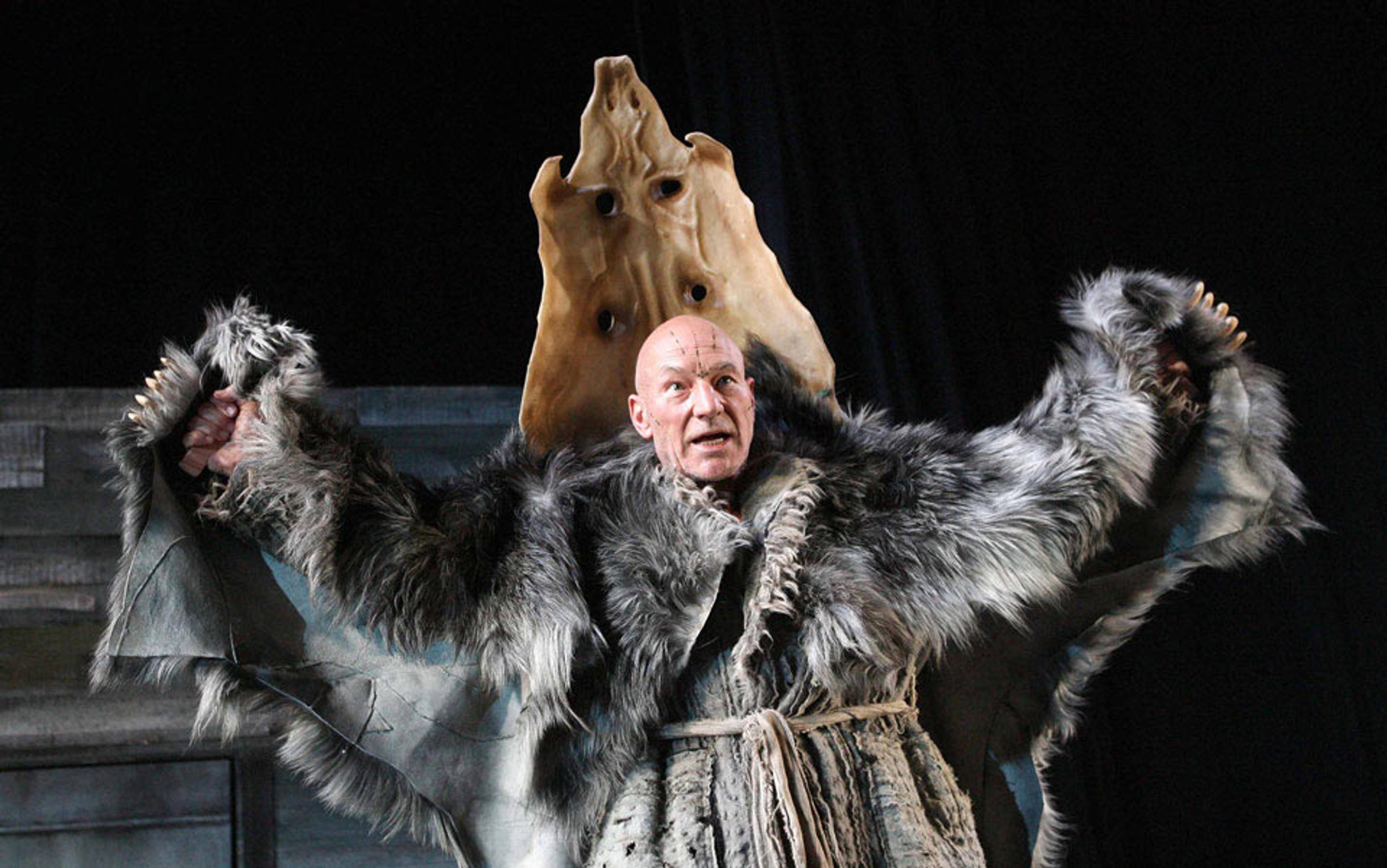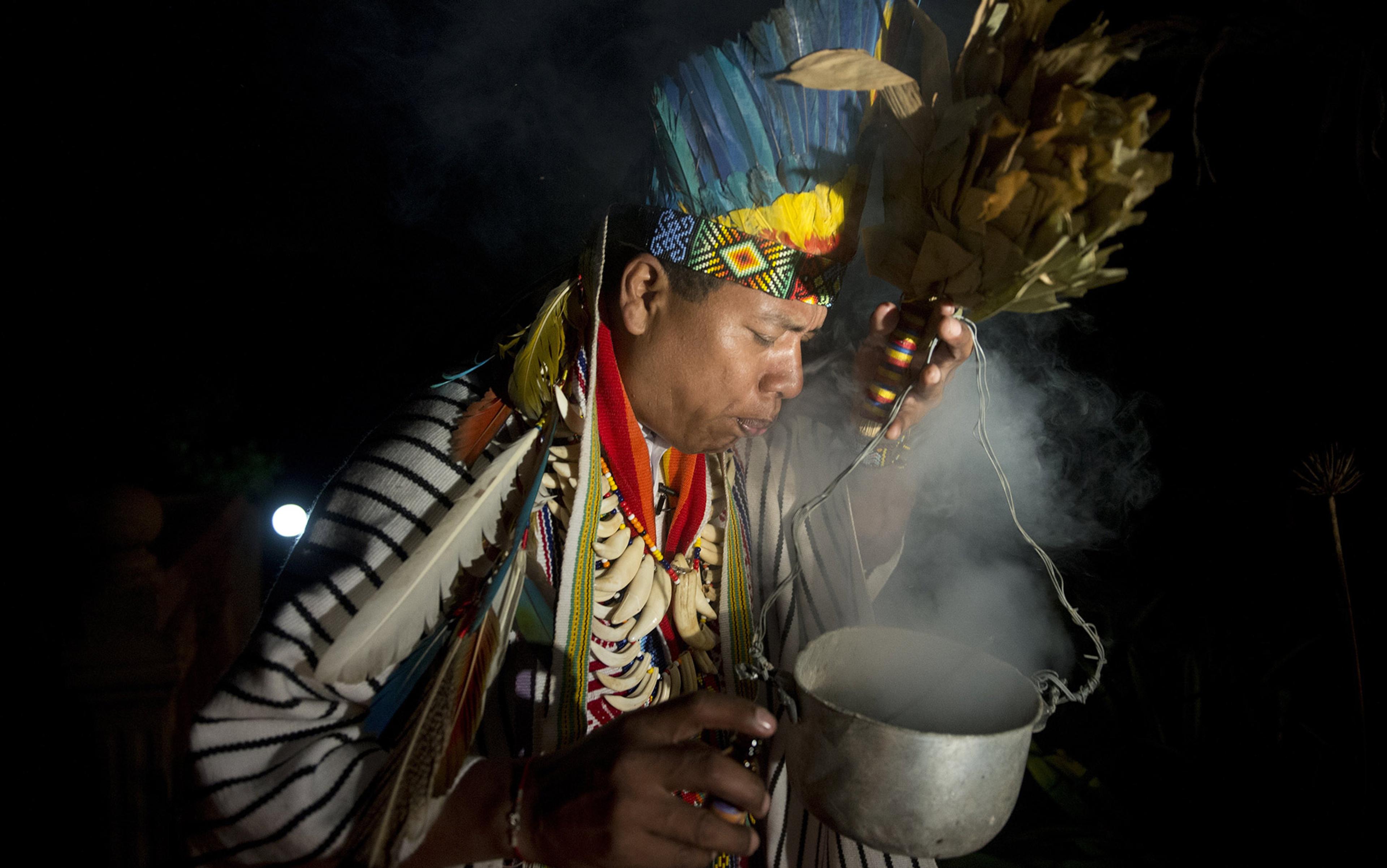Shamanism is as varied as those who practise it. Its practitioners range from indigenous lineages who have passed down their craft over thousands of years to the modern ‘plastic shamans’, who represent no specific culture but have adapted shamanism to meet the demands of metropolitan markets. However, there is a common theme to shamanism wherever it is practised: the use of spiritual (or shamanic) trance to facilitate journeys to a non-ordinary reality. Here, in this non-ordinary reality, the shamans do their work. According to the historian of religion Mircea Eliade writing in 1951, shamanism is the ‘technique of ecstasy’, involving the purposeful invocation and use of dreams and visions to solve problems.
By this definition, shamanism is the landscape of the spirit-journey, populated by good and evil spirits and the souls of the deceased and yet-to-be-born. It is the place where mountains speak and Grandmother Skeleton points out which plants to eat when the dry season lasts too long. In this form, shamanism is everywhere in the old ways of humans. Every tribal culture – alive or dead – has some broker of spiritual capital. The Indonesian Mentawai have their sikerei. The Inuit have their angakok. The Columbian Desana have their paye. The Mongolian Buryat have their böö. The American Sioux have their heyoka.
The sheer magnitude of our shamanic ancestry means one of two things: either shamanism originated once prior to the human diaspora some 70,000 years ago and has been preserved since, or it has arisen independently countless times in premodern human cultures. If we consider that preagricultural human societies are each experiments in how to run a village, with each competing in the evolutionary market of survival and reproduction, then we must ask: what good is shamanism?
The answer is a lesson in both the psychology of problem solving and the construction of meaning. In order to get there, we first have to understand what the prominent explanations of shamanism are in contemporary anthropology. These explanations all rely upon a common set of psychological and evolutionary principles, and these principles in turn explain the adaptive value of shamanism.
One explanation holds that shamans are beta-versions of modern healers. They treat everything from tiger bites to depression. Their expertise in medicinal plants and associated healing practices extends from the physical to the psychological. This happens because many tribal cultures do not differentiate between the material and mental in the same way that modern science often does. It is also well-known that many of the plants used by traditional healers have active properties and are used accordingly. But this explanation doesn’t say much about a key element in shamanic practice: the shamanic trance.
A second prominent explanation is that shamans exploit human gullibility by taking advantage of psychological biases, such as the human fear of ‘dread risks’. These are risks that are essentially arbitrary, or outside of one’s control, but can nonetheless wipe out entire families or villages. Modern examples include plane crashes, terrorist attacks, nuclear meltdowns, pandemics and the like: events with low probability, but very high consequences. The science shows that humans will pay a lot to minimise these risks, even if the associated consequences are more lethal over the long run. In this case, some anthropologists claim, the shamanic trance represents a kind of folk proof that shamans can protect people against dread risks. The shaman can interact with invisible forces and effectively neutralise them.
A third argument holds that shamans organise social groups around common beliefs. These, in turn, lead to better outcomes for the group as a whole. For example, using the threat of magical retribution, the shaman can keep everybody from killing the last gazelle. This mitigates a ‘tragedy of the commons’ scenario, in which shared resources are overused and depleted. Shamans can also unite the tribe around arbitrary decisions by making them sacred and putting everyone on the same page, thereby eliminating potential conflicts over where to hunt, what crops to plant, or whether to fight or flee a neighbouring tribe. This extends to organising groups around social-commitment ceremonies that enhance cooperation and create the soothing in-group vibrations common to traditions such as Thanksgiving and Hanukkah.
The shamanic ability to organise social groups around common beliefs is certainly an advantage. It might seem at first to be a somewhat weak evolutionary explanation, but in fact the opposite is true. Consider the following example. Up until the arrival of the Europeans, much of North America was home to peoples whose ancestors had crossed over the Bering Straits roughly 20,000 years before. But by the mid-1800s, Europeans were arriving in a steady drove, and the Native Americans were under serious threat. They needed to repel the invaders. But what was to be done?
The Buryat shamans blossomed like wildflowers as people sought new ways to control the uncertainty
In 1889, a Nevadan Paiute elder named Jack Wilson had a dream-vision of a sacred dance that would enlist the spirit armies of the dead. This dance would lead to the inevitable swallowing of White people by the Earth. It became known as the Ghost Dance.
The Ghost Dance was immensely attractive, and it united previously warring tribes from Oklahoma to California. With a common enemy and a belief in divine providence, the Native Americans organised themselves and their beliefs in a way that had never been seen before. They became a far more formidable force by working together rather than singly. This terrified the US government, and contributed to rising conflict, which eventually culminated in the Massacre of Wounded Knee in 1890.
Though the Lakota were savagely killed by US soldiers, the Ghost Dance offers a powerful example of the potential strength of shamanism as a social organiser. But while this explanation for shamanism is heavily supported, it cannot be the entire explanation since there are many things that organise people: shared hunts, competitive sports, simple fireside songs. So what exactly is the evolutionary added-value of shamanic trance and how in the world does it work?
Here is a crucial clue: shamanism often arises among people exposed to uncertainty. A case in point is the recent rise of shamanism among the Buryat in Upper Mongolia. Following the collapse of socialism in 1989-91, the economic rug was pulled out from under the Buryat. This led to terrible poverty and starvation among a people whose cultural identity had largely been rubbed out over a series of generations. In this existential vacuum, the Buryat shamans blossomed like wildflowers as people sought new ways to control the uncertainty in which they had found themselves.
But shamanic powers are not seen as methods for defying the natural order, as one anthropologist found out when he tried to convince a shaman to engage in a rain ceremony, to which the shaman replied: ‘Don’t be a fool, whoever makes a rain-making ceremony in the dry season?’ Shamanism is not a method of controlling reality in defiance of one’s own experience. Shamanic peoples, just like the majority of Western Christians, prefer Western doctors when they can find them. Shamanism does not make one blind to the power of penicillin. Rather, it is only when visible technologies fail that people look for help from forces outside this world.
To understand what shamanism adds, let’s take a step back and take a look at how minds, especially human minds, work. All organisms require resources to keep themselves alive and to reproduce. This has led to one of the most prominent theories on the evolution of the mind. Put simply, the mind is a search algorithm. Minds make their living by being able to find things. Food, mates, a good place to hide, effective methods of revenge, and the means to reach your goals, whatever they may be – all of these and more are targets of the mind’s searching eye.
Whereas many animals use their brains to search in physical space, human minds (and those of some other animals) can search via simulation. That is, the brain can simulate potential future realities. This is possible because brains like ours encode a mental model of the world. By searching inside that mental model, we build narratives that tell us how to get from one place to another. Sometimes we do this backwards, by constructing counterfactual alternatives to explain how, if we had behaved differently, things might have gone. But just as often, we conjure up simulations to better understand how to influence outcomes in the future.
You might get only one chance to decide which house to buy, which partner to marry or what project to invest the next 10 years of your life in. Our brains allow us to solve these problems by projecting ourselves into alternative versions of these potential futures. This is called self-projection, which already starts to hint at the shamanic forces that might lie therein.
The hungry cats scratched and clawed at everything – until they eventually, randomly, figured out how to escape
Sometimes, however, we don’t even know what we’re looking for. The threat of collective starvation from a bad harvest. The death of a child. The decimation of one’s entire village from a landslide. Such problems unravel the semantic connective tissue that holds reality together. They don’t seem to play by the rules of our past experience. When that happens, humans need a ‘search engine’ that knows how to do what Google cannot: to generate search terms for a problem that they don’t yet fully understand.
When minds can’t find things, they engage with the random. A desert ant that can’t find its nest starts hunting randomly. When in 1898 the psychologist Edward Thorndike put hungry cats in puzzle boxes made to be super tricky to get out of, the cats scratched and clawed at everything – until they eventually, randomly, figured out how to escape. And when the human mind gets stuck on a problem it can’t solve, it starts adding noise to past solutions until it eventually hits on something that might work.
There is an old computer algorithm called simulated annealing that helps to explain why this works. It simulates the method by which metal, when heated and cooled on a certain schedule, can be made harder. By heating it, one relaxes the crystal structure of the metal, allowing the randomness of jiggling atoms to literally explore the space of metallic configurations. When it is cooled after this temporary heating, the metal can find a more solid arrangement.
Similar metaphors of high-temperature exploration are found throughout biological evolution. Some genes can alter their mutation rates in response to environmental heterogeneity in a process called evolvability. Bacteria can randomise their own genetic information by a stress-induced uptake of genomic material floating around in the soup they swim in. These evolutionary strategies insert randomness in direct response to uncertainty.
The mind’s use of randomness is how we think new thoughts and come up with creative solutions to vexing problems. This is an inbuilt feature of minds such as ours, and one we don’t often notice. If you sit quietly and let your mind wander, you can get a glimpse of this randomness at work, as your daydreams put together odd combinations in a kind of Rube Goldberg approach to problem solving.
But we also use randomness more purposefully. For example, when we use practices such as the I Ching or Tarot card readings, we are engaging in a form of exploratory divination.
Such practices have been used for thousands of years to help people understand their problems by confronting them with meaningful but random interpretations. Appropriately used, these methods can help to escape one’s natural biases by being forced to consider alternative hypotheses. These can, upon consideration, lead to new insights, especially in situations where there are no competing solutions.
Shamanism is a form of exploratory divination. But this doesn’t yet explain the full extent of its power. The final step towards understanding shamanism’s adaptive contribution also makes it clear why shamanism is such an effective social organiser, why it might offer an extra-strength placebo effect in psychosomatic healing, and why it can capture the tribe’s collective capacity for fear.
Shamans do this by accessing a particular part of the mind. Through purposeful and yet exploratory investigation, shamans make lucid the mental associations that lurk quietly underneath our understanding of reality. As what the US ethnobotanist Terence McKenna in the 1980s called ‘astronauts of inner space’, shamans help to make explicit a part of our mind that is thousands, if not millions, of years old.
No one did a more thorough job of explaining the characters that populate this inner space than the US literature scholar Joseph Campbell. In The Hero with a Thousand Faces (1949), Campbell set out the basic narrative figures that are common to countless cultures. The hero, the wise elder, the mother/sister/love-interest, the trickster, and the dark shadow are all themes that appear throughout humanity’s many stories and explanations of itself. The US filmmaker George Lucas used Campbell’s work as an inspiration for Star Wars (1977), which sheds interesting light on the elements of our narrative addiction. These narrative figures and the challenges they face are embodied in characters such as Luke (the hero), Obi-Wan (the wise elder), Leia (the mother/sister/love-interest), Han (the trickster), and Darth Vader (the dark shadow). In a deep psychological sense, these figures are the molecules of meaning that fuel human narrative.
Shamanism uses in-built associations to construct meanings for which the mind has a natural affinity
For those fond of depth psychology, these characters are Carl Jung’s archetypes, the Rosetta Stone by which our unconscious mind makes sense of reality. If you are an evolutionary psychologist, they are the survival and mating modules that compete for our attention (‘Is it a threat?’ ‘Is it an opportunity for love?’ ‘Is he someone I can trust?’ ‘Is this the end?’). If you are a secular Buddhist who takes the practice of mindfulness as an opportunity to get a hawk’s-eye-view on the mind, then these are the vines on which the monkey mind swings. In Why Buddhism Is True (2017), the US science writer Robert Wright combines these ideas to make clear the shoulder-sitting angels and devils of human motivation.
Through the ritualised invocation of these mental spirits, shamanism makes these characters explicit. In so doing, it offers us the opportunity to make sense of our reality in the mental light of forces that are hard-wired into our understanding. An evolutionary bias towards seeking out the safety of mother figures, avoiding enemies, respecting the wisdom of our elders, and for seeing ourselves as the heroes of own adventures is a powerful advantage over creatures that might fail to make such associations.
As a form of exploratory divination, shamanism uses these in-built associations to construct meanings for which the mind has a natural affinity. There is little that is as important as this constructed meaning. Research consistently finds that experiencing a coherent and meaningful life is one of the strongest predictors of our wellbeing. By meaningful, I mean having a story to tell, a higher reason as to why one thing happened and not another. This makes us feel good and helps us to act in ways that are consistent with our higher goals, instead of pursuing more short-term pleasures.
In his memoir Black Elk Speaks (1961), the spiritual leader and sacred clown (heyoka) of the Oglala Sioux put it like this:
When a vision comes from the thunder beings of the West, it comes with terror like a thunderstorm; but when the storm of vision has passed, the world is greener and happier… You have noticed truth comes into this world with two faces. One is sad with suffering, and the other laughs; but it is the same face, laughing or weeping … as lightning illuminates the dark, for it is the power of lightning that heyokas have.
To gain mastery over reality is to create a mythology worth living for. Your head is the space from which all meaning derives. It is the shaman’s role to shine light on that meaning in order, like a wind-up doll, to make you go.






